Discovering Lightsaber Mechanics in Jedi: Fallen Order


Intro
Lightsabers have captivated imaginations since their first appearance in the Star Wars universe. In Jedi: Fallen Order, they are not merely tools for combat but embody the essence of a Jedi’s journey and their unique connection to the Force. This article aims to dissect the mechanics of lightsabers within the game, exploring their construction, combat techniques, and customization options.
Overview of Jedi: Fallen Order
Jedi: Fallen Order is an action-adventure game developed by Respawn Entertainment and published by Electronic Arts. Set in the aftermath of Star Wars: Episode III – Revenge of the Sith, the narrative follows Cal Kestis, a young Jedi who narrowly escapes Order 66. The game brings to life stunning visuals and a deep story set against the backdrop of the Star Wars galaxy. What makes it stand out is its emphasis on the lightsaber mechanics, which enhance both gameplay and the emotional journey of its protagonist.
Lightsaber Construction and Symbolism
In the game, the act of constructing a lightsaber is not just mechanical but a rite of passage. As players progress, they gather parts that reflect their journey and choices. The components range from hilts to crystals, each influencing the appearance and prowess of the weapon. For example, a player might opt for a sleek hilt that allows for faster maneuvers or a heavier one that packs a punch.
Beyond mere aesthetics, each lightsaber part tells a story. Crystals, sourced from various locations, resonate with the Force, reminding players of the historic significance tied to these weapons. Crafting your own lightsaber showcases a key aspect of the Jedi identity – individuality and mastery forged through experience.
Combat Techniques
Combat in Fallen Order revolves around fluid lightsaber mechanics that feel both weighty and precise. Players can execute a range of techniques, from basic slashes to intricate combos. The gameplay encourages a strategy that mimics the calculated movements of a Jedi warrior combatting their foes.
- Blocking: Players can deflect blaster shots and parry enemy attacks, fostering an intense back-and-forth dynamic.
- Force Abilities: Integrating Force powers with lightsaber strikes boosts the combat experience, weaving narrative and gameplay seamlessly.
- Stamina Management: The game incorporates a stamina system, making each swing count. Players must be thoughtful, balancing offense and defense.
These mechanics not only elevate the action sequences but also drive players to adopt a more tactical mindset, reflecting the discipline of a true Jedi.
Customization Options
Now comes the fun part: customization. Cal Kestis can personalize his lightsaber in various ways, which carries implications on gameplay. Players can tinker with:
- Hilt Design: Various hilts provide different grips and styles, catering to personal preferences.
- Blade Color: The blade color signifies more than aesthetic choice; it represents the player’s connection to the lore.
- Material Choices: Materials impact durability and appearance, opening avenues for creative expression.
This customization becomes a narrative thread as players can express not just who they are as gamers but how they see themselves as Jedi.
Visuals and Effects
Visually, Jedi: Fallen Order showcases impressive graphics that create an immersive atmosphere throughout the game world. The way lightsabers illuminate the dark corridors of ancient temples or clash against enemies produces an engaging spectacle. Animation details—like the swinging arc of a lightsaber during combat—impart a visceral experience, conveying the weight and impact of each strike. Moreover, soft particle effects when lightsabers clash deliver satisfying feedback, heightening the overall gameplay experience.
The visuals reinforce the lore, making players feel as if they are part of an epic saga, living the Jedi experience through their choices and actions.
The combination of intricate mechanics and deep narrative concerning lightsabers in Jedi: Fallen Order offers players a rich exploration of Jedi lore. As players navigate through dilemmas and combat, they continuously engage with the lightsaber’s significance, making for a compelling gaming journey.
Prologue to Lightsabers in Jedi: Fallen Order
Lightsabers are more than just flashy weapons; they represent the very essence of what it means to be a Jedi. In the context of Jedi: Fallen Order, their mechanics not only enhance gameplay but also weave a rich narrative tapestry that draws players into a galaxy teeming with lore and conflict. To grasp the full weight of the role lightsabers play in this game, one must consider not just their combat abilities but their symbolic importance and the intricate crafting process that allows personalization.
Delving into the lightsaber mechanics reveals the game's commitment to authenticity and depth. Throughout the journey, players engage in crafting, mastering combat techniques, and developing strategic approaches that hinge on their lightsaber skills. This is not merely a tool for violence; it is emblematic of the character's journey, growth, and the moral complexities faced in a galaxy recovering from a devastating conflict. Understanding lightsaber mechanics offers insight into the balance between gameplay and storytelling, an aspect vital to the game's reception among players.
Background of Jedi: Fallen Order
Jedi: Fallen Order is set in a dismal period for the Jedi, long after the events of Star Wars: Episode III – Revenge of the Sith. Players find themselves in the shoes of Cal Kestis, a young Padawan who survives Order 66 and seeks to navigate a universe where the Jedi are hunted nearly to extinction. The portrayal of lightsabers within this context reflects not only the character's struggles but also the broader themes of hope, resilience, and the fight against tyranny.
In this universe, lightsabers are not merely weapons; they are a relic of a lost order and a beacon of hope for those still fighting the good fight. Cal's journey from a scared survivor to a fighter armed with a lightsaber encapsulates his growth as he faces overwhelming odds and encounters various factions intent on claiming his life. The mechanics tied to lightsabers thus serve to reinforce the game’s narrative arc.
The Cultural Significance of Lightsabers
Lightsabers have transcended their original role in the Star Wars galaxy to become an iconic symbol in popular culture. They represent the struggle between good and evil, power and responsibility. The cultural weight they carry can be felt deeply within Jedi: Fallen Order, where every swing and encounter reverberates with these larger-than-life themes.
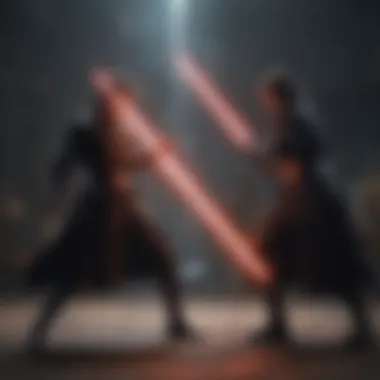
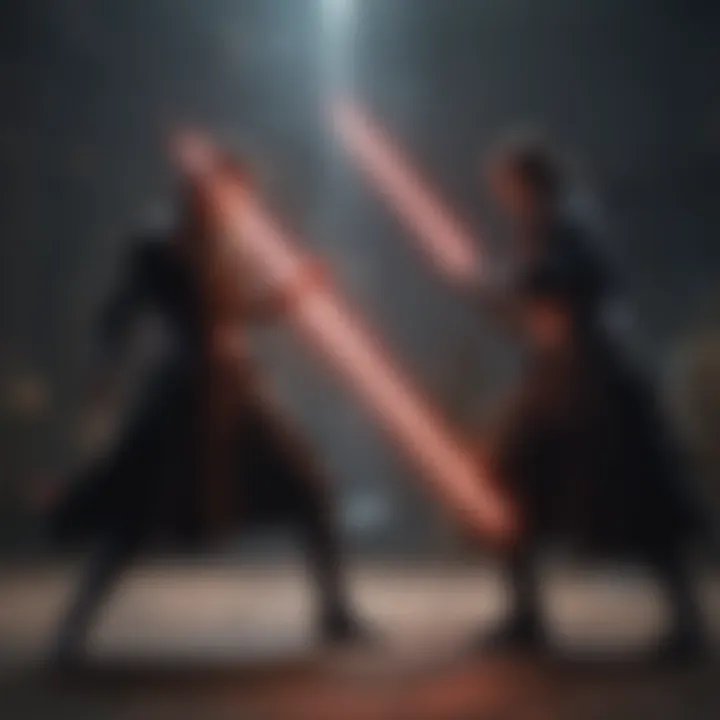
Each lightsaber is a unique artifact, often reflecting the character that wields it. From the choice of crystal to the hilt design, every element tells a story. This personal touch gives players a sense of ownership over their journey and connects them more firmly to the lore of the Jedi.
"In a galaxy defined by its rich history and conflict, the lightsaber serves as the ultimate avatar for choices made and paths taken."
Moreover, the act of wielding a lightsaber in Jedi: Fallen Order gives players a physical sense of power and control, making the experience immersive. Beyond just the thrill of combat, it evokes a sense of nostalgia and belonging in the Star Wars fandom. The game not only celebrates this iconic weapon; it reinvents it for a new generation, embodying the same spirit of adventure and heroism that has captivated audiences for decades.
Lightsaber Crafting Mechanics
Lightsaber crafting serves as a cornerstone experience in Jedi: Fallen Order, adding depth to player engagement and contributing significantly to the overall mechanics of the game. This unique feature not only enhances gameplay by allowing custom personalization but also grounds the lightsaber in a rich narrative that resonates with long-time fans of the Star Wars universe. The process of creating a lightsaber involves several elements that cater to both functional prowess in combat and the symbolic significance of the weapon itself.
Components Needed for Crafting
Crafting a lightsaber is no simple task, requiring various components collected throughout the game. Players will come across several key parts, which are essential to the process:
- Emitter: This is where the energy blade protrudes from. Different emitters influence the way the lightsaber looks and might even affect certain combat attributes.
- Hilt: The hilt is crucial as it determines how the lightsaber feels in the player’s hands. Choices made here impact balance and maneuverability.
- Crystal: The heart of the lightsaber, the crystal not only powers the blade but also gives it color and energy. A variety of crystals can be found, each altering the lightsaber's abilities or effects.
- Switch: This is the mechanism used to activate and deactivate the lightsaber. Some switches offer unique functionality or reflect better aesthetics that align with the player's style.
- Color Schemes: Though often seen simply as aesthetic choices, they can also be tied into gameplay, offering moral implications or themes.
This diverse range of elements allows players to dive into crafting with a tailored approach, mirroring the individualized journeys of the characters within the game.
Design Choices and Their Impact
The design choices players make when crafting their lightsabers are far from superficial. They impact not just aesthetic appeal, but also the functionality of the weapon. For instance, selecting an emitter that enhances damage might make the lightsaber feel more aggressive, while a hilt designed for better grip might favor a defensive play style.
- Combat Style: Each combination of components leads to a different feel during combat. Players leaning towards aggressive tactics may select components that increase speed or damage, while those preferring a more tactical approach might prioritize balance and control.
- Visual Appeal: The look of a lightsaber can be a form of personal expression. Whether a player opts for a traditional blue, a fierce red, or an unusual green, these choices can signify their role-play within the greater universe.
- Player Identity: The crafting of a unique lightsaber can enhance the sense of identity within the game. Players might feel more connected to their character and the ongoing narrative, deepening their immersion.
Ultimately, lightsaber crafting combines both strategy and personal expression, demonstrating that every choice made is richer than it appears on the surface. A lightsaber in Jedi: Fallen Order is not merely a weapon; it is an extension of one's identity and approach to the game.
"The lightsaber is more than a tool; it embodies the spirit of the Jedi—the struggle between light and dark, a reflection of the Jedi’s journey."
Combat Techniques with Lightsabers
When it comes to lightsaber mechanics in Jedi: Fallen Order, the combat system is one of the most engaging aspects of the game. Players not only wield these iconic weapons but also deploy a series of techniques that make every encounter electrifying. Understanding combat techniques is essential, as they play a pivotal role in both survival and enjoyment in the galaxy far, far away.
Basic Combat Mechanics
At the core of combat in Jedi: Fallen Order lies the basic mechanics that govern how one engages in lightsaber duels. Players quickly learn to execute simple attacks, parries, and dodges which are essential skills to master before diving into more complex techniques. The controls are designed to be intuitive, allowing players to feel the weight and flow of their lightsaber motions.
- Light Attacks: Consisting of rapid slashes that can be strung together, light attacks are the bread and butter of a player's arsenal. The rhythm of combining these attacks fosters a visceral engagement with the game's combat.
- Heavy Attacks: These involve slower, more powerful swings that can break through an enemy’s defenses. They can be especially useful against tougher opponents who might block standard attacks.
- Parries and Counters: Timing is everything here. A successful parry not only deflects an attack but opens up your opponent for a counterattack, creating a dynamic encounter where reflexes are tested.
To succeed, players must blend these basic techniques fluidly. A common pitfall is rushing in without regard for defense; patience often pays the best dividends in battle.
Advanced Techniques and Skills
Once players have a good grip on the basics, the game rewards them with more advanced techniques that deepen the combat experience. Mastery of advanced skills can elevate a player from merely surviving to dominating encounters.
- Force Powers: Skills like Force Push or Force Pull can disrupt enemy formations or create openings. Using these powers strategically can set up devastating combos.
- Aerial Attacks: These involve launching into the air to attack foes from above. Aerial assaults can catch opponents off-guard, especially when followed up by a heavy attack.
- Mixing Combat Styles: Combining lightsaber skills with Force powers creates hybrid combat moves that are visually rewarding and tactically advantageous. For instance, using Force Slow before unleashing a series of rapid light attacks can help players manage the battlefield.
Utilizing these advanced techniques requires practice, but the payoff is rewarding. Not just visually, but in their capacity to handle diverse enemy types effectively.
The Role of Strategy in Combat
In the heat of battle, it’s easy to become lost in the action. However, lightsaber combat in Jedi: Fallen Order demands a strategic mindset. The importance of planning ahead cannot be overstated. Players need to consider a few aspects to enhance their in-game effectiveness:
- Knowing Your Enemies: Each enemy type has strengths and weaknesses. Observing their moves and recognizing attack patterns allows for tailored responses.
- Positioning: It’s not just about attacking; where a player stands can make or break a fight. Luring enemies into choke points or utilizing the environment to one’s advantage can turn the tide of battle.
- Resource Management: Players have limited healing items. Recognizing when to engage aggressively and when to retreat can save a player from a sticky end.
"In Jedi: Fallen Order, the real mastery isn't just about wielding the lightsaber, it's about outsmarting the enemy. Strategy elevates the experience from mere combat to an art form."

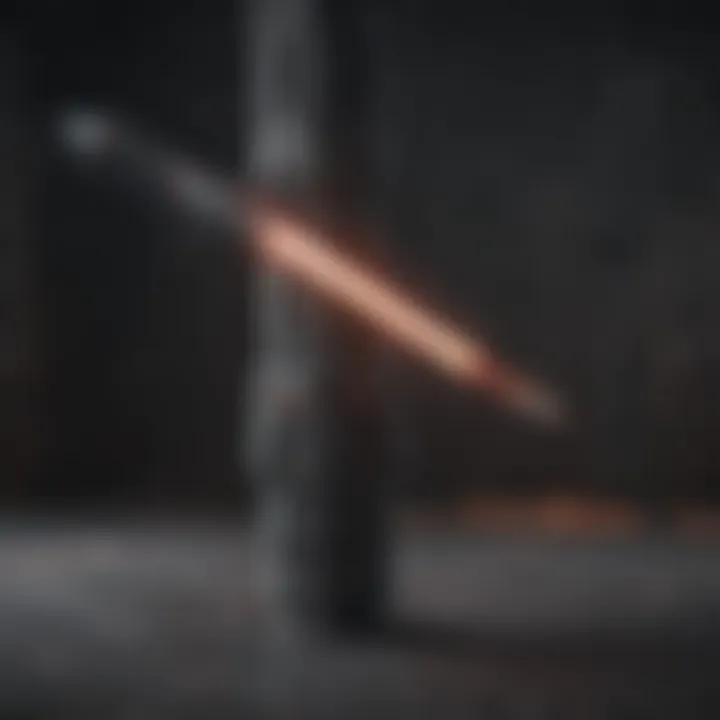
By merging basic, advanced techniques with strategic planning, players can create a unique playing style suited to their preferences.
Understanding combat techniques with lightsabers in Jedi: Fallen Order delivers players an enriching experience that goes well beyond simple button mashing.
Customization Options Available
Customization in Jedi: Fallen Order stands out not just as a feature but as a core element that enhances the player's connection to the game. Lightsaber customization is deeply woven into the gameplay experience, offering players a unique opportunity to tailor their combat experience and personal touch. It speaks to the heart of what makes this title engaging, allowing users to channel their creativity while also improving efficiency in battle. The ability to customize lightsabers impacts both the gameplay mechanics and the personal narrative that players construct as they progress through the game.
Customization for Combat Performance
When it comes to combat, the customization options available for lightsabers are not merely superficial changes but have real impacts on gameplay. Players can change components such as the hilt, blade color, and even the material used, which can enhance combat abilities. For instance, swapping out certain emitter components might increase damage output or unlock special attacks.
In essence, combat performance is not standardized; rather, it hinges on these custom choices. Players who opt for a longer blade may find they can strike enemies from a distance, making them less vulnerable during intense skirmishes. Conversely, those who select a shorter, more agile blade may benefit from quicker strikes, which could be essential for dodging faster foes. This balance of power and agility allows for a myriad of combat styles, ensuring each player's experience feels unique.
- Benefits of combat performance customization include:
- Tailoring to individual play styles.
- Formulating strategies based on preferred combat techniques.
- Enhancing specific stats like speed, damage, or special abilities.
The strategic decision-making does not stop at simple efficiency. Players can also adapt their customization choices based on the environment and the type of enemies encountered, making it a dynamic aspect of gameplay.
Aesthetic Customization Choices
On the other side of the coin, we have the aesthetic customization choices. These options allow players to showcase their personality and style. Whether it is through the color of the lightsaber blade or intricate designs on the hilt, aesthetic customizations create a visual language between the player and their character.
Choosing a vibrant purple blade might resonate with a player’s personality, representing creativity and uniqueness in combat. Meanwhile, a classic blue or green might fit those who prefer to remain within the traditional Jedi lore. The understanding of colors and their meanings add layers to the experience, as players can align their aesthetic choices with personal values or aspirations.
"Customization in lightsabers reflects more than just gameplay; it's about connecting emotionally with the character you embody. It's an alliance of form and function that resonates deeply with players."
Furthermore, exploring different materials for the lightsaber hilt can change not just appearance but also imply different stories and heritage. Players might gravitate towards a weathered look that tells tales of battle rather than a new, sleek design. This aspect elevates character storytelling, as players can forge a unique narrative simply through their choices in lightsaber design.
Narrative Relevance of Lightsabers
The narrative significance of lightsabers in Jedi: Fallen Order transcends their function as mere weapons; they serve as potent symbols woven into the fabric of storytelling and character progression. Lightsabers encapsulate the enduring struggle between light and dark—a theme that resonates throughout the broader Star Wars universe. The use of lightsabers in the game not only enhances combat mechanics but also amplifies the emotional stakes for players as they engage with the narrative.
By wielding a lightsaber, players step into the shoes of Cal Kestis, immersing themselves in the trials and tribulations faced by a fledgling Jedi. This experience is emblematic of the broader journey that countless characters have undergone within the Star Wars canon. Each lightsaber is not just a tool for combat, it's a representation of identity, legacy, and values. As players learn the nuances of lightsaber combat and customization, they uncover layers of meaning that inform their understanding of the Jedi Order's philosophies and struggles.
"The lightsaber is not merely a weapon; it's a reflection of one's convictions and a narrative thread connecting the player to the lore of the Jedi."
Symbolism of the Lightsaber
Lightsabers symbolize more than the physical prowess of their wielders; they represent the ideals of hope, skill, and moral conflict within the game. For many players, the act of collecting parts and constructing their own lightsaber becomes a rite of passage, mirroring the journey of self-discovery that Cal embarks upon. It’s not just about defeating foes, but about mastering one's fears and doubts.
The appearance of a lightsaber also evokes strong emotions—the color of the blade, for instance, signifies the wielder's alignment. A blue blade represents a guardian, exemplifying loyalty and protection, while red blades suggest corruption and power. These visual cues nurtured a deeper connection with the lore and the character’s journey.
Moreover, the act of wielding a lightsaber varies from player to player. Some may come down heavy-handed and aggressive, while others might adopt a more elegant, defensive approach. This variability creates a personal connection and encourages players to think not only about their combat style but also about the emotions and motivations behind their actions. Through this lens, the lightsaber becomes a character in its own right, whispering tales of heroism and sacrifice.
Lightsabers in Character Development
In Jedi: Fallen Order, lightsabers are integral to the character arcs of both Cal Kestis and the supporting cast. As Cal develops into a skilled Jedi, his relationship with his lightsaber evolves, paralleling his growth. The lightsaber acts as an extension of his identity, mirroring his struggles against the oppressive forces of the Empire and his efforts to reclaim the Jedi legacy. With each new combat technique learned or customization adopted, players witness an evolution in Cal's identity, reflecting growth from an insecure survivor to a determined Jedi Knight.
Furthermore, the lightsaber's role extends to other characters in the game. Figures like Cere Junda and Greez Dritus provide varying perspectives on what wielding a lightsaber symbolizes. Their insights illuminate the complexities of struggling with past traumas, aligning players with the emotional weight of these characters.
The narrative richness offered by lightsabers can’t be understated. They drive home the message that the path to becoming a Jedi is fraught with challenges, testing not just physical abilities, but moral convictions. Recognizing this complexity shapes player experiences, encouraging them to ponder the broader implications of their choices while swinging their lightsabers in battle.
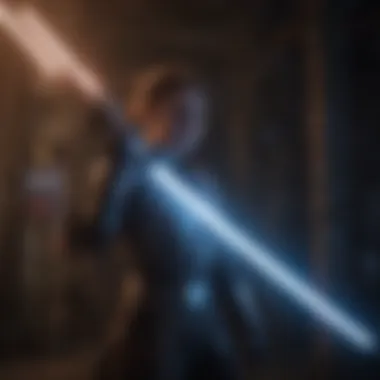
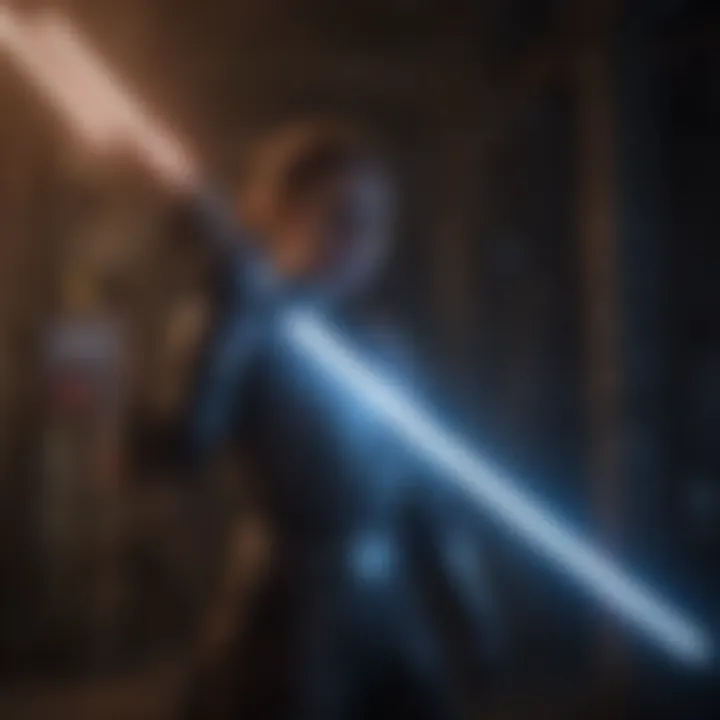
Challenges and Limitations
In the world of Jedi: Fallen Order, lightsabers serve as more than mere tools of combat; they are integral to the player's journey and the storytelling experience. However, with any complex game design, there come challenges and limitations that developers must manage. These challenges can significantly influence gameplay, narrative depth, and ultimately, player satisfaction.
Balancing Combat and Story
Balancing combat mechanics with a compelling narrative is akin to walking a tightrope. On one hand, players come to Jedi: Fallen Order expecting intense lightsaber duels, the thrill of engaging foes with deft maneuvers and powerful strikes. On the other, they want a story that resonates on a deeper emotional level, where the lightsaber is not just a weapon, but a symbol of hope, struggle, or personal growth.
Successful integration of these elements requires meticulous design decisions. For instance, longer cutscenes can pause the flow of gameplay but are necessary to flesh out characters and plot. Conversely, an explosive encounter might push the narrative to the background. Over time, players might feel there's a disconnect between what they wield the lightsaber for and the story being told.
Achieving harmony between these facets often comes down to player choice. Allowing gamers to engage in various combat styles while exploring the lore can provide a sense of agency. This choice allows for a more personalized experience that resonates with different audiences. However, if not managed correctly, it can lead to frustration. As players navigate intense combat only to be thrust back into lore-heavy moments, it creates an oscillating rhythm that can feel disjointed if the transitions are not seamless.
Technical Constraints in Game Design
While storytelling and mechanics play pivotal roles, technical constraints can often pose significant hurdles. Game developers are tasked with creating a visually stunning environment that takes full advantage of the lightsaber's unique capabilities. However, limitations in graphics rendering, AI behavior complexities, and physics simulation can affect how lightsabers are experienced within the game.
"A lightsaber in motion should feel smooth and impactful, but technical limitations can create a jarring experience if not executed flawlessly."
One example of this is the age-old struggle with collision detection. When swinging a lightsaber, players expect every strike to connect with satisfying impact. However, if the game's engine struggles to replicate this, it detracts from the immersion. Additionally, the multiplayer aspect could introduce lag, disrupting the combat flow and leading players to feel undermined by technical glitches.
Developers have to strike a balance between fidelity and performance. They need to ensure that visuals do not come at the cost of gameplay fluidity. This often leads to compromises where some features, though ideal, are shelved or streamlined. Ultimately, the constraints can lead both to creative solutions and to missed opportunities for innovation.
Players' Reception of Lightsaber Mechanics
Understanding how players perceive the lightsaber mechanics in Jedi: Fallen Order reveals significant insights into the game's design philosophy and overall player engagement. The lightsaber is not just a weapon; it embodies the essence of the Jedi experience. From its construction to its combat usage, players form a unique bond with these iconic weapons. Feedback on these mechanics offers a window into what resonates with gamers and what aspects might require a bit of polishing.
Community Feedback and Critiques
The reception from the gaming community regarding lightsaber mechanics has been a mixed bag, yet the overall sentiment leans positive. Players have often celebrated the fluidity of swordplay, with many mentioning that the combat feels responsive and dynamic. One gamer even remarked that swinging their lightsaber felt like an extension of their very being, resonating with the thrill of being part of the Jedi mythology. However, some critiques have emerged, especially about the depth of combat mechanics.
"The lightsaber feels great, but sometimes I wish I had more moves to play with. A few extra combos here and there wouldn’t hurt!"
This sentiment reflects a desire for enhancements without jeopardizing the elegance already present. Many in the community have expressed an interest in seeing more combos, special attacks, or even unique fighting styles tailored to different lightsaber forms—like the more aggressive Djem So or form-fitting Soresu.
Other elements, such as the crafting of lightsabers, have garnered attention as well. Players appreciate the ability to personalize their hilt and color, with discussions buzzing on platforms like Reddit about favorite designs and color combinations. Such discussions foster community engagement, creating a shared culture around lightsaber aesthetics and their significance within the game.
Comparative Analysis with Other Titles
When we pit Jedi: Fallen Order against other titles featuring lightsaber mechanics, like the Star Wars Battlefront II series or Force Unleashed, certain distinctions emerge. In Battlefront II, lightsaber combat is often viewed as more arcade-like, with a focus on flashy executions than on tactical combat. Players noted that while it enhances the spectacle, it often lacks the depth that Fallen Order aims for.
On the flip side, Force Unleashed, while known for its over-the-top powers and combat, lacked the progressional sophistication that Jedi: Fallen Order has brought to the table. The progression system in Fallen Order allows players to feel a sense of growth and mastery as they learn new techniques. In contrast, many players felt that Force Unleashed pushed them to rely too heavily on the game's cinematic spectacles rather than on their skills.
Overall, Jedi: Fallen Order is often praised for finding the sweet spot between approachable combat mechanics and deeper game design, contributing to a rewarding experience. This combination of factors leads to a robust dialogue within the gaming community, shaping how future Jedi-themed titles might develop their mechanics.
Ending: The Impact of Lightsabers in Jedi: Fallen Order
The lightsaber acts as more than a mere weapon in Jedi: Fallen Order. It represents the heartbeat of the gameplay and the narrative that unfolds. Through effective mechanics and diverse customization options, players are not just wielding swords of light; they are engaging deeply with the Star Wars legacy, exploring a universe that continues to captivate imaginations.
Future of Lightsaber Mechanics in Gaming
Looking ahead, the evolution of lightsaber mechanics in gaming appears promising. Future titles may take cues from Jedi: Fallen Order, adopting intricate crafting systems and nuanced combat techniques. Players might expect not just to customize the aesthetics but also to influence gameplay directly through choices that shape flow and tactics in battles.
Game developers could consider integrating new technologies, such as VR or AR, enhancing the immersive experience of lightsaber combat. Imagine a scenario where players feel the weight of their lightsaber, feel the burn of a narrowly missed attack or build even richer connections with their character. Furthermore, numerous titles might explore more complex narratives surrounding lightsabers, expanding the existing lore rather than sticking to classic tropes.
Final Thoughts on the Player Experience
Diving into the Jedi: Fallen Order experience reveals that lightsabers are central to player identity and engagement. Crafting a lightsaber is an intimate process, allowing players to insert their personality into the game. Whether it’s the choice of material or the color of the blade, each decision serves to create a unique connection with the character.
Games like this highlight how nuanced mechanics can pull players into storytelling in a way that goes beyond traditional cutscenes. Traversing the game with a personalized lightsaber becomes an experience that resonates with both core players and newcomers alike. Moreover, the interplay between swordplay and strategy encourages players to evolve their techniques, making them feel accomplished as they refine their combat skills.
"The weapon of a Jedi is a reflection of their journey, each swing and strike echoing their growth."













